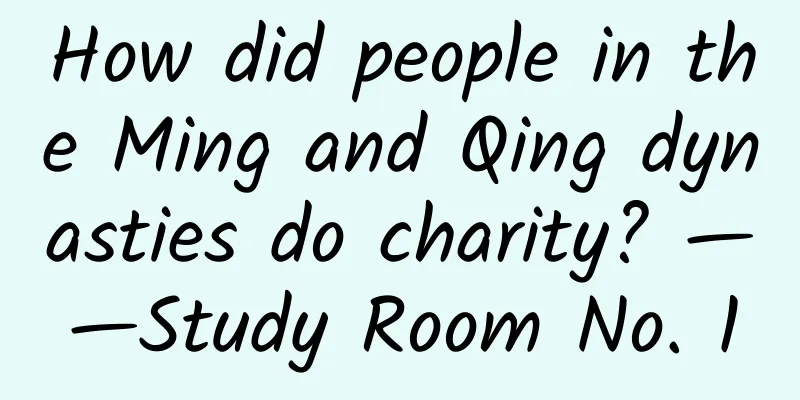How did people in the Ming and Qing dynasties do charity? ——Study Room No. 1

|
Study Room No. 1, learn about public welfare together Today, Yizai will learn about the history of charity with everyone and see how the charity halls and charity associations operated in the Ming and Qing dynasties. The Macau Tong Shan Tang was founded in the 18th year of the reign of Emperor Guangxu of the Qing Dynasty (1892). It provides a variety of charitable services, including saving the dying and the wounded, and helping the world. The service recipients are of all nationalities, and it is still active today. The charity organizations formed spontaneously by the people began in the late Ming Dynasty and early Qing Dynasty, and continued until the founding of New China, when they ceased to operate and were reborn after the reform and opening up. Similar to the action goals of current public welfare organizations, researchers' attention to charity organizations that have lasted for more than 300 years comes from two aspects: one is "social welfare" and the other is "civil society." This spontaneous civil organization, which is independent of clans and the government, not only carries out charitable activities, but its influence on "citizen autonomy" has also become a focus of scholars. It is even considered to have "opened up a public sphere" and is a "community" in the city. The advertising effect of the Donglin Party Among the scholars who study charities, one of the more authoritative ones is actually from Japan. He is Fuma Jin, a professor at the Graduate School of Literature at Kyoto University, who was born in 1948. Since 1979, Fuma Jin has visited China many times and collected information from many sources. After 16 years, he completed the "Research on the History of Chinese Charities", which has become an important work in this field. According to the "Research on the History of Chinese Charities", among the charities in the Ming and Qing dynasties, the "Tongshan Society" was established the earliest, and this system had a great influence on later generations. Before the Ming Dynasty, China already had various relief facilities. The state had the obligation to provide relief to the widowed, the orphaned, and this obligation was written into the law as early as the Han Dynasty. The state-managed orphanage was almost a symbol of every prefecture and county in the Ming Dynasty. However, the orphanage under the feudal bureaucratic system had many corrupt practices and malpractices in its management. Charity associations were another set of relief programs independent of the state relief system. As early as the 18th year of the Wanli reign (1590), Yang Dongming, an official of the Ming Dynasty, founded the Tongshan Society in his hometown of Henan. Its foundation was a friendly association among the celebrities in Yucheng County. It was originally named "Tongle Society", and later changed its name to "Tongshan Society" on the grounds that "Tongshan is the most joyful". Members paid dues together and used them to build roads and bridges, and to help the poor and sick. Members also had regular social gatherings and dinners. Fu Ma Jin compared this organization to groups like the "Lions Club" and "Tongxin Club" today, and believed that it was the source of the Tongshan Society system. Later, the Tongshan Society gradually weakened social activities and focused on education and charity. In the 42nd year of the Wanli reign (1614), Gao Panlong, Chen Youxue, Qian Yiben and other famous scholars of the Donglin Academy also organized the Tongshan Society in Wuxi, Jiangsu, and became famous throughout the country due to the influence of the Donglin Party. The Tongshan Society in this area continued to exist until the reign of Emperor Kangxi. In the turbulent society of dynasty change, it always maintained its vigorous vitality and promoted the emergence of similar organizations in other regions. Recommendation system and credit records The organization and management of the Tongshan Society vary greatly, but they all have similarities. For example, four lectures are held each year, and the organizer of the lectures is called the "chief", who takes turns. The chief is selected by recommendation, and the person in charge does not need to be an official, but must have good character and management ability. According to relevant records, in the first spring meeting of the Jiashan County Tongshan Society in the fifth year of Chongzhen (1632), 70 envelopes and 19 taels of silver were collected for membership fees; in the thirteenth year of Chongzhen (1640), 459 envelopes and 93 taels, 4 coins and 1 fen of silver were collected. This shows that the number of members increased, and on average each person received a little more than 2 coins of silver, which was not a burden for an average family. However, the objects of relief by the Tongshan Society were treated differently. The first objects of relief by the Tongshan Society were the poor and helpless filial sons and virtuous wives, and the second were the poor and elderly families who were not taken into the poorhouse and had no ability to beg. As for ordinary civilians, the "main association" could only make some meager donations based on its own judgment. As for those poor people who ignored ethics, were unfilial and idle, they were not included in the scope of relief. The recipients of relief are recommended by the members after investigation. The Tongshan Association issues a certificate to the recognized poor people, which is called a "check-up slip". It records the name, address, age, appearance, name of the recommender, registration year, etc. of the recipient, as well as the record of relief received every quarter of each year. The poor receive relief according to the certificate, and the distribution place keeps a copy for reference. At the end of each relief period, the main association is obliged to compile and publish the names of donors and the relief situation as an accounting report for members, also known as the "credit record". The credit record is very important. The Fengjing Town Tongshan Association had delayed the issuance of the credit records in the eighth and ninth years of the Xianfeng period, which attracted much discussion among members, and they were suspected of hiding dirty tricks behind the scenes. Some Tongshan Associations invited the county magistrate to do a "third-party review" when changing terms to show fairness. In the Qing Dynasty, since several donations a year were too cumbersome, it became popular to set up real estate in the name of the Tongshan Society, and many charities and charity halls owned their own land and real estate. Not only did the fundraising method change, but the educational speeches that were often given at assemblies in the Ming Dynasty were also given by officials and township officials, and the Tongshan Society only focused on relief work. In villages where there were no celebrities or wealthy people, the Tongshan Society operated by having each person save one penny of silver every day and donate it after the autumn harvest. They also implemented Zhu Xi's community granary system, lending grain to the people and providing it free of charge to those who were unable to repay. Various forms of charity organizations Other charity halls and charity associations were established almost at the same time as the Tongshan Society in the late Ming and early Qing dynasties. The most popular one was the Yuyingtang, which was found in almost every place. It was inherited from the Ciyou Bureau of the Song Dynasty. The foundation behind the Yuyingtang was a charity association called Yuyinghui. For example, during the reign of Emperor Kangxi, many officials participated in the Yuyinghui in their private capacity, which was established in Xizhao Temple. In the 45th year of Emperor Kangxi's reign (1706), the emperor ordered the establishment of Yuyingtang in all prefectures, counties and cities across the country, and incorporated it into the national institutions. The emergence of orphanages was not only driven by the concept of "universal lifesaving", but also had a certain social background. Some scholars believe that the establishment of orphanages in Fujian during the Qing Dynasty was mainly to deal with the increasingly prevalent phenomenon of drowning and abandoning baby girls in society, and to prevent social problems such as imbalanced population gender ratios and corrupt morals caused by drowning and abandoning baby girls. In addition, there are various forms of charity halls and associations, such as the Bone Burial Association, which specializes in collecting and burying ownerless remains, the Release Association, which collectively releases various animals, the Life-Saving Association, which rescues people in flood disasters, and the One Life Buddha Association, a temporary organization for famine relief. The basic relief rule of the One Life Buddha Association is to compile the "Cao Ju Hungry Household Book", which has three sections on each page. The first section records the name of the rescuer, the second section writes "Recruit one life" (recruit multiple people, or multiple people recognize one person), and the third section writes the name of the recipient and the date of relief, and regularly gives rice and money. This can be said to be the initial form of one-to-one relief. Another famous charity in the Qing Dynasty was Pujitang, which started from the "Road Repairing Compassion House" outside Guangning Gate in Beijing, which helped migrant workers who came to Beijing to build roads and ended up begging on the streets. He Zhuo, one of the "Four Masters of Calligraphy" in the early Qing Dynasty, wrote an article "Pujitang Ji", in which he believed that the state-established charity house was for the poor and unfortunate people, and that no one with a bit of backbone would be willing to go there. Moreover, it only accommodated locals, and the poor who left their homes could only die on the roadside. This is also the reason why the Beijing Pujitang, which is purely privately operated, was established. Yongzheng, who was still a prince at the time, donated 1,000 taels of silver to Pujitang. After he ascended the throne, he issued an edict ordering the construction of infant care halls and Pujitangs throughout the country. Since then, the role of state bureaucrats in the establishment and operation of Pujitangs has expanded, so that many Pujitangs similar to the original orphanages have appeared, as well as many "image projects" established by local officials to seek credit. However, the general understanding at the time was that orphanages were state-owned and Pujitangs were privately operated. In the late Qing Dynasty and early Republic of China, the government had no time to take care of social assistance, and private charity associations and charities played a greater role. Fengtian Tongshan Hall was the largest charity organization in Northeast China in modern times. After the founding of New China, its main part was converted into the Shenyang Red Cross Hospital. Modernization of traditional charity The charitable associations and charitable halls in the late Qing Dynasty already had the characteristics of modern charitable organizations. In terms of the concept of relief, these organizations not only focused on solving the problem of food and clothing for the "recipients", but also emphasized the cultivation of the latter's survival skills, and began to reduce or even cancel the moral requirements for the recipients; in terms of organizational operation, the ability of the government to intervene in the affairs of charitable associations and charitable halls in the late Qing Dynasty was increasingly weakened, and the autonomy of private charitable associations and charitable halls began to increase, and the management became more scientific and standardized, and began to have the characteristics of modern enterprises. The charitable associations in the late Qing Dynasty and early Republic of China were also obviously influenced by the charities of Europe and America. At the end of the 19th century, newspapers such as Shenbao and Dongfang Magazine compared China's "good deeds" with the charities of Europe and America, believing that European and American charities had advantages in motivation and institutional methods, and advocated "modernization of good deeds". "Good deeds" were also more often replaced by the term "charity". After the Sino-Japanese War of 1894-1895 and the Russo-Japanese War, a large number of Japanese went to China. Among them, a scholar named Furuya Seiichi published the "Investigation Report on Fengtian Tongshan Hall" in 1927. What surprised him was that compared with Japanese charitable organizations that mostly relied on a certain philanthropist to fund and operate, Fengtian Tongshan Hall was obviously a comprehensive facility with a large amount of assets centered on real estate, which could last forever. In fact, the origin of Fengtian Tongshan Hall was the cowpox bureau established in the seventh year of Guangxu (1881). Later, it developed into a comprehensive institution consisting of 15 departments including Jiliangso (a re-education facility for prostitutes), orphanages, poor people's vocational training centers, industrial women's factories, and Red Cross hospitals. This is not unrelated to the learning of Chinese charities and government-run charitable organizations from Europe and the United States. Tongrentang in Shanghai, Xingrenhui in Ningbo, Fuaitang in Guangdong, etc. are all such comprehensive charitable organizations. What also surprised Gu Jiacheng was the "self-governance" of Tongshantang, which achieved its results independently and smoothly. His compatriot Fu Majin believes that the late Ming and early Qing dynasties, when charitable organizations and charitable halls were widely present, were a rare era in Chinese history when charitable organizations and associations were formed. Charitable organizations first appeared in cities, where wealth and people gathered, and economic growth and the flow of people to cities became prerequisites. If we want to define charity associations and charitable halls, charity associations are free associations that individuals voluntarily join for the purpose of doing good deeds, while charitable halls are where the charity associations’ offices are located and where the charitable deeds are actually carried out. Fu Majin believes that it is precisely because of the tradition of charity associations and charitable halls that the unprecedented “new-style associations” that pursue new goals together can emerge. In 1912, Zhu Youyu, a Shanghai native, published "The Spirit of Philanthropy and Fraternity in China" in the United States. He mentioned the word "public" many times and believed that these spontaneous associations of people created local autonomy in the city. It was the inherent Chinese spirit of charity and fraternity that supported this local autonomy that could become the foundation of the democratic country that was bound to come. This article is reproduced with permission from the Public Welfare Times. This is the content of this issue of "Study Room No. 1". If you have any questions you want to discuss, you can leave a message and we can study together. |
Recommend
Giants' performance improved, but Japanese consumer electronics revival is difficult
Japanese electronics giants Panasonic , Sony and ...
Get the operation guide of placing game ads on Toutiao today quickly!
Advertising is a process of selection Advertising...
What is Mini Program traffic exchange? How does traffic exchange work in WeChat Mini Program?
Q: What is the Mini Program exchange? A: Mini Pro...
Can consumption be doubled by optimizing information flow using these 3 copywriting tricks?
Today we are going to talk about the black techno...
Iced coffee, iced water, iced milk, iced tea... How to drink iced drinks in a healthy way?
The recent weather is hot and annoying Iced coffe...
How to do bidding analysis? Share 4 major skills!
Competitive product analysis is one of the must-d...
Why hasn't the smallpox virus been eradicated?
Recently, the Global Times reported that frozen b...
Why is sepsis so likely to kill people? Six facts you must know
Speaking of "sepsis", you may feel unfa...
Is there something wrong with my eyes? Why do these weird stripes appear when I take photos of a TV screen with my phone?
When we pick up our phones or cameras and shoot a...
CES2015: 264-core Tegra X1 scores more points than Apple A8X
NVIDIA released the Tegra X1 processor at noon to...
How to activate the Juliang Qianchuan platform? How to promote Juliang Qianchuan?
Douyin's Juliang Qianchuan connects Douyin st...
Meizu App Store promotion information flow advertising delivery process and billing method!
1. Introduction to advertising types 1. App Store...
Analysis of Lenovo's internationalization path: buy, buy, buy
Lenovo Group, led by Yang Yuanqing, has entered t...
Article: Ma Yili divorces netizens: This is the difference between Huawei Mate and P series
[[271997]] Wang Xuehan and Ma Yili announced thei...
For a sprained joint, should you apply heat or cold?
In daily life, various joint sprains are common, ...









